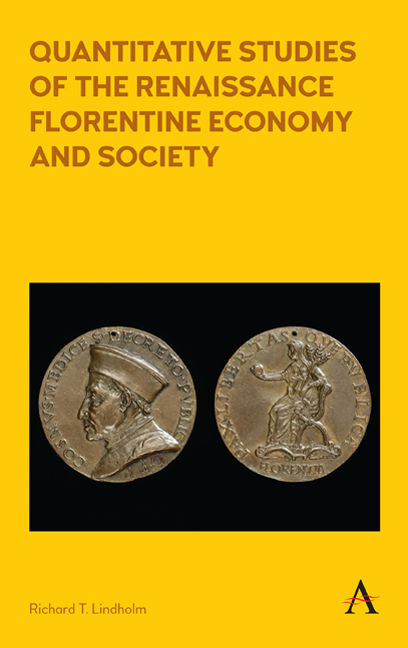Book contents
- Frontmatter
- Dedication
- Contents
- List of Illustrations
- Preface
- Acknowledgments
- List of Abbreviations
- Introduction
- Part I RISKS AND RETURNS
- Part II SOCIETY
- Chapter Three The Chances of Getting Rich in Renaissance Florence: The Wool Industry Occupational Wealth Hierarchy
- Chapter Four Palaces and Workers: Neighborhood Residential Segregation in Renaissance Florence
- Chapter Five The “State” Makes a Work of Art: The Impact of the Catasto Homeowner Tax Loophole on the Quattrocento Florentine Palazzo Building Boom
- Chapter Six Not Getting Ahead in Life: The Lack of Life-Cycle Wealth Accumulation in Quattrocento Tuscany
- Part III WORK
- Conclusion
- Glossary
- Bibliography
- Index
Chapter Three - The Chances of Getting Rich in Renaissance Florence: The Wool Industry Occupational Wealth Hierarchy
from Part II - SOCIETY
Published online by Cambridge University Press: 10 January 2018
- Frontmatter
- Dedication
- Contents
- List of Illustrations
- Preface
- Acknowledgments
- List of Abbreviations
- Introduction
- Part I RISKS AND RETURNS
- Part II SOCIETY
- Chapter Three The Chances of Getting Rich in Renaissance Florence: The Wool Industry Occupational Wealth Hierarchy
- Chapter Four Palaces and Workers: Neighborhood Residential Segregation in Renaissance Florence
- Chapter Five The “State” Makes a Work of Art: The Impact of the Catasto Homeowner Tax Loophole on the Quattrocento Florentine Palazzo Building Boom
- Chapter Six Not Getting Ahead in Life: The Lack of Life-Cycle Wealth Accumulation in Quattrocento Tuscany
- Part III WORK
- Conclusion
- Glossary
- Bibliography
- Index
Summary
Introduction
It is difficult to study the Italian Renaissance without studying its wealth. In a highly visible way, wealth financed the creation of the renowned art and architecture of Renaissance culture. In a less visible way, it largely determined an individual's social standing in the commercial Renaissance society. The importance of wealth in the cultural and social worlds inextricably links both to the economic world that produced that wealth. This chapter shows how the creation of wealth at the household level was highly volatile and explores the implications of that observation for Renaissance society.
The Renaissance Florentines made efforts to organize their economy. As part of this effort, production was organized around guilds. Each guild was associated with a level of social status. The arte maggiore structure divided Florence into a hierarchy of major and minor guilds. Guilds were fundamentally economic entities, and many of their regulations were designed to reduce uncertainty for members. Regulating production prices and quality helped guarantee income and reduce wealth volatility within each occupation. This could, in turn, lead to a correlation between occupation and income and create a hierarchy that generated significant inequality and a lack of mobility.
Historians’ opinions are mixed about the implications of the guild system for Florentine social status.4 Armando Sapori points out the importance and role of this hierarchy, and Epstein sees prestige as the key difference between the arte maggiore and the popolo minuto. Brucker, though, argues that guilds did not demarcate classes, and Goldthwaite contends that guild membership was not the critical determinant for social position: “in Florence guild membership did not necessarily define a man's economic activity, let alone his economic status.”
The key question, therefore, is the extent of the influence of guilds, through the occupational structure, on household wealth. In other words, it asks how much of a household's wealth was determined by the household head's occupation. The core of this study analyzes wealth volatility conditional on the household head's occupation for the set of occupations in the wool industry during the mid-Quattrocento. The size of the wool industry as well as its diversity of occupations makes an ideal focus for this type of analysis. The 1427 catasto makes it the perfect sample for this kind of study.
- Type
- Chapter
- Information
- Publisher: Anthem PressPrint publication year: 2017



